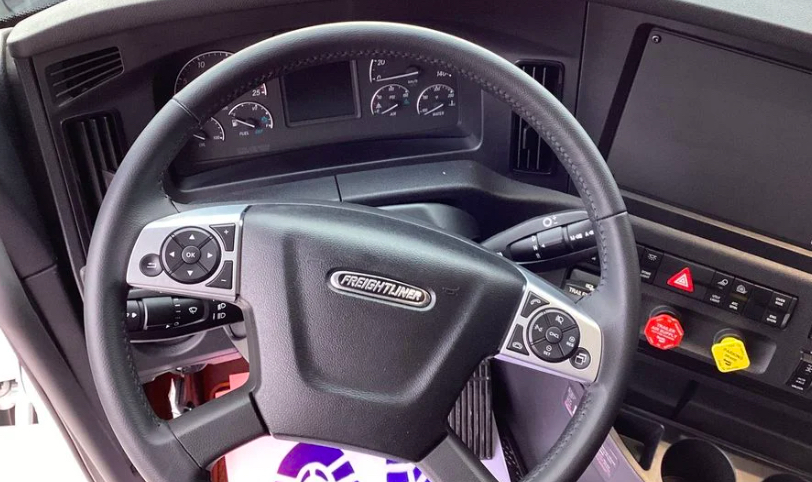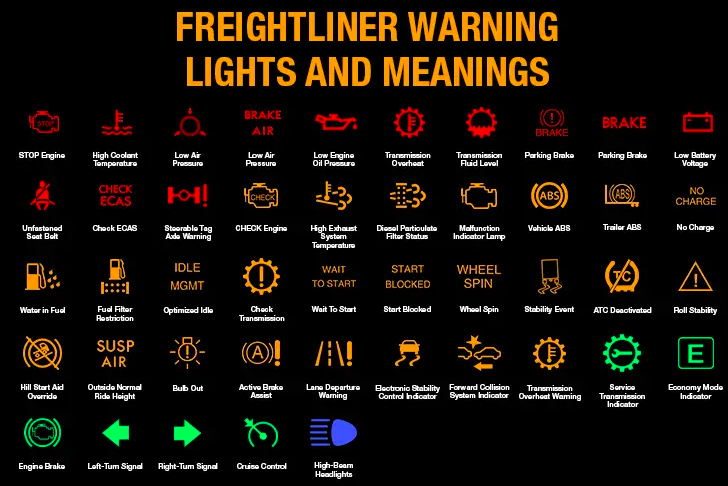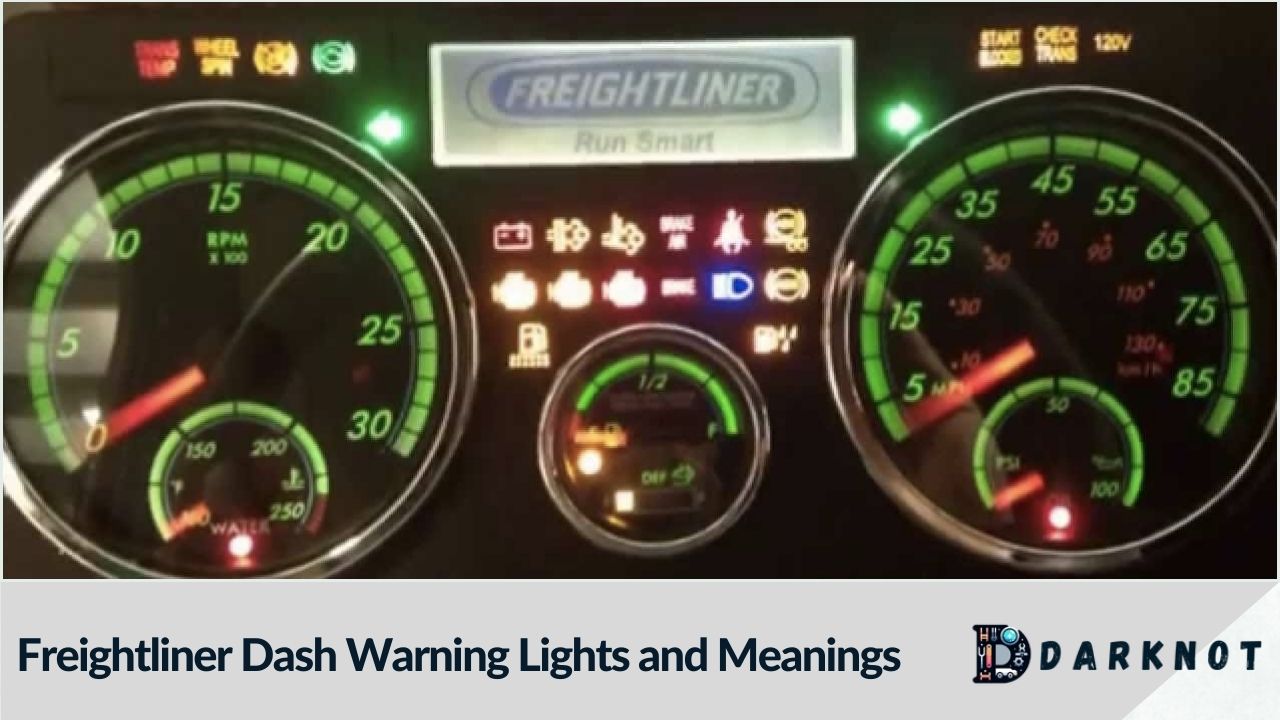Delve into products we stand behind, all meticulously reviewed to simplify your decisions. Your purchases through our links support our mission to deliver top-notch content. Discover how we sustain our work.
Since the 1940s, Freightliner Trucks has been a key player in the transport sector, earning a reputation for reliability and trustworthiness in commercial vehicles. Central to any car, including Freightliner, is the dashboard—a vital driver hub offering crucial data on vehicle performance and safety.
Knowing the meanings behind the warning lights and symbols on a Freightliner dashboard is essential for drivers. These indicators can flag various issues, ranging from minor to major safety risks. This guide aims to demystify Freightliner dashboard signals, empowering drivers to maintain their vehicles effectively.
Freightliner Dashboard General Information

The Freightliner dashboard is designed to keep drivers well-informed about their vehicle's condition. Familiarity with the dashboard's layout and critical monitoring points is vital for recognizing warning signals.
Typically, a Freightliner dashboard includes instruments like a speedometer, tachometer, fuel, and temperature gauges—key tools for monitoring the vehicle's speed, engine RPMs, fuel status, and temperature. Additionally, the dashboard features a range of warning lights and symbols.
These dashboard indicators serve as alerts for potential vehicle issues, covering low oil pressure, overheating, or battery problems. They also highlight concerns with the brakes, transmission, or exhaust system.
Furthermore, the dashboard uses icons to communicate critical information, such as the status of the anti-lock braking system (ABS), diesel particulate filter (DPF), or trailer ABS. Understanding these symbols is crucial for identifying and addressing vehicle problems.
Colors Of Freightliner Dashboard Warning Lights
Understanding Freightliner dashboard lights is crucial. They vary in color, each indicating urgency levels. This guide explains what these colors mean for drivers.
- Red lights demand immediate action to avoid accidents or damage, like low oil pressure or serious engine issues.
- Yellow/amber lights suggest caution, advising prompt attention to prevent issues like engine or Electronic Stability Control problems.
- Green and blue lights on the dashboard provide information or confirm a system is active without immediate concern needed. Understanding their function is key.
For instance, the low beam indicator signifies the activation of low beam headlights, while the cruise control light confirms the cruise control system is in use.
Common Freightliner Dash Warning Lights and Symbols

In the Freightliner Cascadia, drivers must be vigilant of various dash warning lights and symbols signaling potential issues across the engine, emissions, brakes, transmission, powertrain, and safety systems.
This overview covers some key Freightliner dash warnings:
Check Engine Light: A common dashboard alert indicating potential engine or exhaust system issues. Prompt inspection by a professional is advisable upon its illumination.
DEF Light: Signals low Diesel Exhaust Fluid levels or a fault in the DEF system. It's crucial to refill DEF or seek a mechanic's inspection promptly.
ABS Light: Indicates a malfunction in the Anti-lock Braking System, necessitating an immediate check-up by a qualified technician.
Brake Pad Wear Indicator: This symbol, resembling a circle flanked by two lines, alerts to worn brake pads needing replacement for safe braking operations.
Transmission Overheat Warning: This symbol alerts when transmission fluid gets excessively hot. It's crucial to stop and let the transmission cool before proceeding.
Powertrain Issue Indicator: Signifies problems with the engine, transmission, or drivetrain, necessitating immediate professional inspection.
Airbag System Alert: Indicates a malfunction within the airbag safety system, requiring prompt examination by a specialist.
Seat Belt Reminder: This symbol serves as a nudge to fasten the seat belt for optimal driving safety.
Collision Avoidance Alert: Represents the Collision Avoidance System (CAS) at work, using a yellow triangle with an exclamation mark to warn of potential collisions, urging immediate preventive action.
Stability and Traction Control Indicator: The Electronic Stability Program (ESP) symbol, a yellow triangle featuring a car and wavy lines, signals ESP activation or fault, aiming to prevent skidding.
Battery and Electrical Warning: A red battery symbol with plus and minus signs warns of charging system issues, while a yellow triangle with an exclamation point flags general electrical faults needing attention.
Troubleshooting Steps Freightliner Dash Lights
To effectively handle a warning light on your Freightliner dash, follow these troubleshooting steps:
- Consult the Owner's Manual: First, refer to the owner's manual to understand the specific warning light's meaning, offering a base for troubleshooting.
- Observe Symptoms: Notice any accompanying symptoms like unusual noises, odors, or performance changes. Document these observations for your mechanic.
- Fluid Level Checks: Ensure critical fluids (engine oil, coolant, brake fluid) are adequate, as low levels can trigger warning lights.
- Battery Examination: Use a multimeter to assess the battery voltage. Low battery power can be a culprit for warning light activation.
- Fuse Inspection: Examine fuses associated with the illuminated warning light. A faulty fuse could be the reason for the light.
If these steps don't resolve the warning light issue, professional diagnostic and repair services from a certified mechanic are recommended. Ignoring warning lights can lead to significant vehicle damage and safety hazards.
Understanding common Freightliner truck dash lights is crucial for appropriate responses:
- ABS Light: Signals issues with the anti-lock braking system.
- Check Engine Light: Points to engine or emission system problems.
- DEF Quality Indicator: Alerts to Diesel Exhaust Fluid system concerns.
- Low Battery Voltage Warning: Indicates charging system or battery issues.
- Water In Fuel Indicator: Warns of water presence in the fuel system.
- High Exhaust System Temperature (HEST) Lamp: Highlights exhaust system problems.
- Diesel Particulate Filter (DPF) Lamp: Signifies Diesel Particulate Filter system issues.
Tips for Preventing Dashboard Warning Lights
Ensuring your Freightliner truck undergoes regular maintenance is key to preventing dashboard warning lights. This includes:
- Routine Pre-drive Inspections: Check the truck's condition before each trip.
- Regular Maintenance Tasks: Change engine oil and filter, replace transmission fluid, maintain the brake system, check tire pressure and condition, and manage the DEF system.
- Load Management: Avoid overloading; ensure the load is evenly distributed to prevent undue strain on the vehicle.
- Coolant Temperature Monitoring: Regularly check coolant levels and ensure clean radiator and cooling system components to avoid overheating issues.
Following these procedures can help underestimate the risk of dashboard warning lights and maintain the truck's optimal performance.
How do you respond to Freightliner Dash Warning Lights?
When encountering dashboard warnings in a Freightliner truck, understanding and responding correctly is crucial to prevent further damage and ensure safety.
Immediate Response to Warnings
Red warning lights demand immediate action. Should one illuminate, safely pulling over and shutting down the engine is advised to avoid exacerbating the issue.
Yellow/amber lights suggest caution; assess whether it's safe to proceed and consider whether the issue can be addressed safely on the road or requires immediate attention.
Deciding When to Pull Over
Certain conditions, like engine overheating or brake issues, necessitate stopping the vehicle safely to prevent damage or ensure safety before proceeding.
Ignoring these warnings can lead to significant damage or safety hazards, underscoring the importance of a timely and appropriate response to dashboard alerts.
Freightliner Dashboard Symbols Quick Guide

The Freightliner Cascadia features a variety of dashboard symbols crucial for driver awareness and vehicle maintenance. Below is a guide to some of the most pivotal symbols and their meanings:
- ABS: Indicates issues within the Anti-lock Brake System, necessitating a professional inspection.
- Check Engine: Signals engine malfunctions, requiring diagnostic checks by a mechanic.
- DEF: Warns of low Diesel Exhaust Fluid levels, calling for immediate refilling.
- DPF: Alerts that the Diesel Particulate Filter needs regeneration, a task for a mechanic.
- Engine Oil Pressure: Points to oil pressure problems, demanding an urgent mechanic visit.
- High Beam: Shows high beam headlights are activated.
- Low Air: Indicates insufficient air pressure, prompting a check and adjustment.
- Low Fuel: Warns of low fuel levels, suggesting a need to refuel soon.
- Low Oil: Signal oil pressure issues, similar to the engine oil pressure warning, require professional inspection.
- Low Voltage: Highlights low battery voltage, advising a battery check or replacement.
- Parking Brake: Reminds that the brake is engaged and should be released before moving.
- Seat Belt: Alerts that the driver's seat belt is unfastened, emphasizing the need for fastening before driving.
- Tire Pressure: Indicates low tire pressure, necessitating a check and adjustment.
- Water in Fuel: Suggests water contamination in the fuel system, requiring a mechanic's inspection.
Understanding these symbols enables drivers to maintain Freightliner Cascadia efficiently, ensuring safety and minimizing the risk of costly repairs.
How To Detect Freightliner Warning Lights?
To effectively address dashboard warnings in Freightliner trucks, leveraging diagnostic tools and resources is essential for swift and precise problem identification.
Modern vehicles are equipped with OBD systems, crucial for monitoring and identifying engine, transmission, and other component issues. These systems utilize sensors to gather data, storing it within the truck's computer. When a dashboard warning illuminates, the OBD system aids in retrieving codes that pinpoint the issue.
Connecting a diagnostic tool to the truck's OBD port allows for code reading and issue identification, facilitating an understanding of the problem's severity and required repairs.
For more intricate diagnoses, mechanics use professional diagnostic scanners. These advanced tools offer comprehensive insights into a truck's systems, capable of conducting component-specific tests and resetting warnings post-repair.
Driver Training and Education
Understanding dashboard warnings is crucial for drivers. Recognizing and promptly responding to these alerts can prevent vehicle damage and safety risks.
Freightliner and other educational platforms offer training on dashboard warnings, equipping drivers with the knowledge to recognize and react to these signals. Access to the vehicle manual, which details warning lights and their meanings, is also vital for informed responses.
Dashboard warnings hold significance beyond vehicle maintenance—they're integral to driver safety and regulatory compliance. Ignoring these alerts can result in legal repercussions, including fines and increased accident liability, especially if neglected warnings contribute to an incident.
Commercial vehicles like Freightliners adhere to strict federal guidelines mandating visible and functional warning lights for critical systems (ABS, engine, transmission). These regulations ensure that drivers are immediately aware of faults, emphasizing the importance of addressing these warnings to avoid safety hazards and legal issues.
Ignoring critical warnings like brake or engine lights can severely impact vehicle performance, increase accident risks, and lead to regulatory penalties, underscoring the necessity of immediate action upon their activation.
In Summary
Recognizing and understanding the dashboard warning lights and symbols on Freightliner trucks is vital for maintaining safety and vehicle performance. These indicators serve as an early warning system for potential vehicle issues, enabling drivers to act swiftly to mitigate any problems before they escalate.
Given the variation in warning lights and symbols across different Freightliner models, drivers are encouraged to become acquainted with the specific indicators relevant to their vehicle. This knowledge can be acquired through the truck owner's manual or consulting a professional mechanic.
Prioritizing vehicle safety and performance is crucial for the driver's benefit and the protection of fellow road users. Quickly addressing dashboard warnings can keep the vehicle running optimally.
To conclude, a thorough understanding of Freightliner dashboard warning lights and symbols is an indispensable aspect of responsible driving. Drivers can uphold the highest vehicle safety and efficiency standards by dedicating time to learning about these alerts and maintaining alertness on the road.

